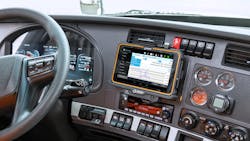The U.S. and Canada can look very similar at times. The two countries have nearly identical rules for truck drivers’ hours of service. But Canada has taken a far more rigorous approach to certify the electronic logging devices that monitor truckers' operations. This has left fleets that operate on both sides of the border with just a handful of ELD vendors to choose from months before hard enforcement of the law begins north of the border.
Just like the U.S., which first began mandating ELDs in late 2017, Canada started its June ELD rules with soft enforcement across its 13 provinces and two territories. The U.S. took about a year before it began stricter enforcement of the federal law. Transport Canada, similar to the U.S. Federal Motor Carrier Safety Administration, has pushed back its hard ELD enforcement to June 2022.
Transport Canada’s strict third-party certification rules make it more difficult for vendors to get the nation’s seal of approval on devices that have become a big part of the trucking industry across North America. While the FMCSA’s list of devices is nearly 500, Transport Canada’s has fewer than 10. About 10% of the FMCSA’s self-approved devices have since been revoked from the list over the past few years.
Canada’s more methodical approach to ELD approval and enforcement highlights a difference between the two nations, which is vital for fleets that operate in both countries. “The advice we give them is to make sure you’re in constant conversation with your providers and their intention of having an approved device in Canada, so you don’t have to go down the road of having two ELDs,” David Heller, Truckload Carrier Association’s VP of government affairs, told FleetOwner.
Isaac Instruments, one of the largest ELD providers in Canada, outfits fleets that are constantly crossing the border, Jacques DeLarochelliere, company CEO and co-founder, told FleetOwner. “If you look at our big data, at any moment, you’ll see that half the trucks on our system are in the U.S.,” he said. “In terms of operations for trucking fleets, there’s no such thing as a border in trucking—except for the paperwork when you go across.”
FMCSA versus Transport Canada
While FMCSA has “wide authority in the states for interstate commerce, at the end of the day in Canada, it’s the provinces that enforce the federal and provincial regulations,” said Steve Keppler, co-director of Scopelitis Transportation Consulting. “And it’s very provincially focused—so there can be a difference from province to province.”
Keppler noted that Ontario, which “has the largest population of traffic and trucks in the country,” recently announced it will start to enforce ELD usage to mirror Transport Canada’s rules. But for intra-province commerce, ELD laws are up to each independent province.
In the U.S., FMCSA distributes money to the states to fund enforcement of federal motor carrier regulations. With that funding comes requirements that states have regulations compatible with federal rules. Transport Canada provides little funding to provinces.
“When it comes to rules in the states, they’re developed on what’s called assumed compliance,” Heller said. “It’s like the law that says you should wear your seatbelt when you get behind the wheel of a car. It doesn’t mean everybody does it—but it does mean it’s required, which shows you there are still tremendous amounts of seatbelt violations out there when people are caught not wearing their seatbelt.”
Much like the seatbelt laws that U.S. states began enforcing in the mid-1980s, compliance with ELDs has increased since the mandates began. As law enforcement in the U.S. has gotten better at understanding ELD devices, violations are starting to rise here, Keppler said. “We’re also seeing, in some cases, carriers are taking liberties with some aspects of the rule that has some gray areas: things like personal conveyance, yard moves, unidentified driving time.”
ELD certification process
North of the border, Transport Canada and the nation’s provinces and territories are now going through that process of dealing with known and unknown challenges that come with ELD integration, Keppler said.
Unlike in the U.S., where the ELD vendors self-certify their devices, Canada has three independent certifying bodies that work with vendors to test and approve devices. And each of the three is taking a different approach to certification, Keppler added. Different test procedures for devices of varying complexity are making the certification take longer.
“I’m sure they would have liked to have all of this stuff done before the regulation went live—but they’re still going through that process now,” Keppler added. “That’s one of the main reasons why they’re not taking a hard enforcement approach at the moment because they recognize that there are issues and they don’t have what they call ‘a saturation of certified devices’ yet.”
As of late November, just eight devices made by seven vendors are certified—now months since the soft ELD enforcement began in Canada. The only vendor with more than one device is Isaac Instruments, which, DeLarochelliere told FleetOwner, provides ELDs and other transportation technology to 40% of Canada’s largest carriers—and 25% across the nation.
DeLarochelliere called the certification process “brutal.” But the services provided by Isaac—and other major transportation technology providers in Canada and the U.S.—is “mission-critical to an essential industry,” he said. “If your system stops working for five minutes, you’ve got drivers on the dock waiting for the next directions. The phones are ringing. You can’t do that. The ELD is the icing on the cake.”
Heller recalled that when the U.S. first started mandating ELDs, many drivers and fleets were against them and fought to continue to keep paper logs of their hours. “Now they don’t want to live without them,” Heller noted. “The data from ELDs has become part of the industry.”
Overall, Keppler said the ELD mandate in the U.S. has been a success and has just become part of the fabric of trucking. However, trucking fleets in the U.S. have had to put more faith in the vendors making the devices. Because if an ELD fails in the U.S., the onus is on the carrier—not the vendor. Canada is putting more pressure on the ELD makers.
The U.S.’s different model of self-certified ELDs means FMCSA has to coordinate with vendors and law enforcement in the field to address challenges and concerns with the many approved devices in use across the country. “These are very technical things and the carriers don’t know all the tech specs—nor should they need to,” Keppler said. “But there are impacts operationally on some of these things that make their way into FMCSA’s FAQ.”
The FMCSA’s FAQ on ELD has more than 300 frequently asked questions covering gray areas surrounding topics from exemptions to data to malfunctions to registrations to cross-border transportation.
Any ELD used north of the border, including U.S.-based fleets crossing into Canada, must have third-party certification. If a device malfunctions in Canada, it is the vendor’s responsibility to take action. This approach protects carriers by ensuring that an independent authority has validated that ELDs comply with technical requirements and cannot be falsified.
Canada’s hard ELD deadline
Like the U.S., the Canadian regulation requires ELDs to track hours-of-service requirements automatically. It aims to reduce fatigue-related collisions. Isaac is a newer entrant into the U.S. market, recently boosting its U.S. workforce and establishing a headquarters in Cleveland. The company has “20-ish fleets” signed up with Isaac in the U.S., DeLarochelliere said. “But it was more about marketing for us—there’s no real difference in deploying a U.S. fleet or a Canadian fleet.”
He noted how several large Canadain-based fleets have U.S.-registered equipment running south of the border. “We don’t count them as U.S. fleets because they’re part of the Canadian group—so it’s nothing new for Isaac to be operating in the U.S.”
As individual provinces focus on their own rules, Transport Canada is still planning a hard enforcement deadline of June 2022—with just eight approved devices in the country seven months before that deadline. Does DeLarochelliere think that’s realistic?
“Isaac is here to help carriers and truckers. That’s what we do,” he said. “How is this going to turn out? I don’t have enough gray hair to understand that yet.”
About the Author
Josh Fisher
Editor-in-Chief
Editor-in-Chief Josh Fisher has been with FleetOwner since 2017. He covers everything from modern fleet management to operational efficiency, artificial intelligence, autonomous trucking, alternative fuels and powertrains, regulations, and emerging transportation technology. Based in Maryland, he writes the Lane Shift Ahead column about the changing North American transportation landscape.


